A Dad and His Son Change the Viking Story Forever
Weekends with the kids are a central highlight in any family. Don’t you get the warm and fuzzies just seeing images of a dad with his arm around his child, walking off to the fishing pond, a sports game, or a movie?
This father and son also had a weekend routine. Not the usual kind – they went metal detecting every weekend. On their outings, they found scraps of metal and other useless, albeit interesting, bits.
Until a day in 2007 when their routine weekly outing changed British history forever.
The Detectors
Meet David Shelan and his son Andrew. As amateur metal detectors, they spent weekend after weekend near their North Yorkshire home in the United Kingdom searching for bits of metal. They trudged through mud and dirt for hours. David had been doing this for six years.

Source: Spinditty
The duo walked, climbed, and slogged through fields, farms, and beaches together, determined not to give up, and certain that one day they’d find something of interest. After all, this area was the site of much of British history.
Some Days Just Feel Unlucky
Not all of the homeowners were, let’s say, cool with the idea of these two tramping through their fields. Imagine someone knocking on your door and asking you if they could walk on your land to find metal scraps. It might sound just a tad weird.
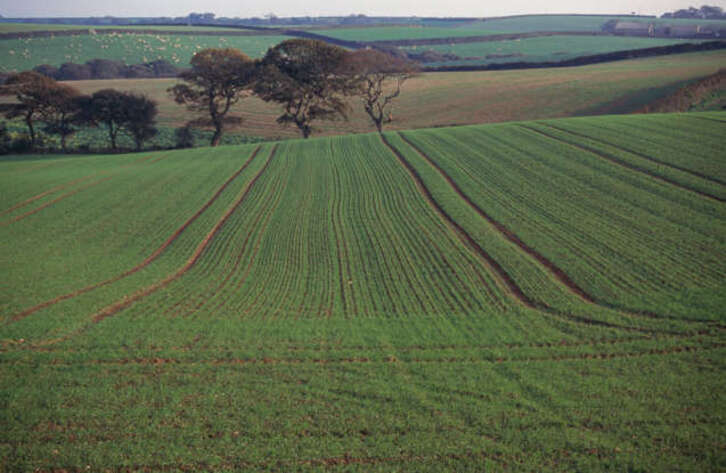
Source: Getty Images
One particular day in January 2007, the Whelans argued with some homeowners, and it gave them the feeling that this was not to be a lucky day. But, like all good detectives, they kept on, scavenging the muddy area for hours, finding nothing.
Buzz!
That’s the sound that is music to the Whelans’ ears – it means something has been found. Beyond excited, David and Andrew picked up their shovels and went at it. As they dug, an even strong buzz went off.
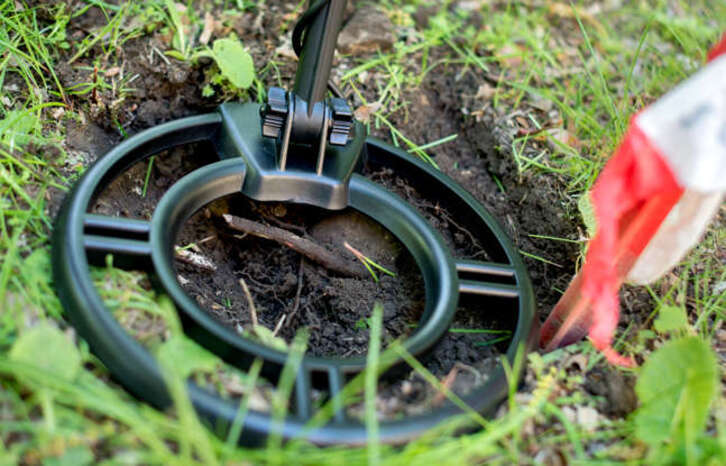
Source: Hauke-Christian Dittrich/picture alliance via Getty Images
For 60-year-old David Whelan, this was the kind of moment that made it all worth it. “I just kept digging,” he said in a later interview. “A ball of earth rolled out to the side of the hole, and I could see a coin stuck in it.” A wondrous find for this determined team – what a moment!
The Find!
David and Andrew had found a silver coin, large and muddy, clearly not British currency. “We knew it was something big,” Andrew said, “and we were shaking with excitement as we lifted it out.”
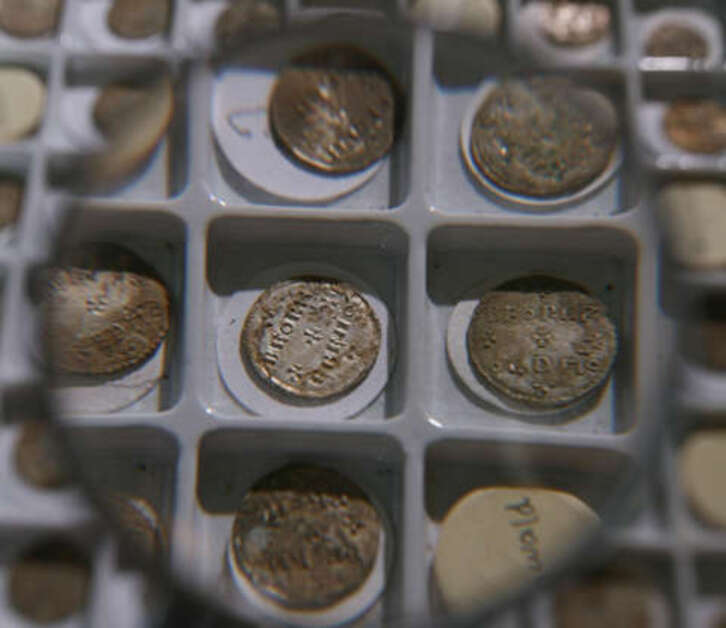
Source: Stefan Rousseau - PA Images/PA Images via Getty Images
Eureka! Time to take the coin home and declare victory for such a significant find after six years of metal detecting. So what did they do? They stayed right where they were – something told them to keep digging in the same spot; it was not yet time to go home.
Not Just a Good Day
What the Whelans found was beyond significant, beyond their own wildest hopes, and perhaps more importantly beyond the imagination of historians. There were 617 coins, jewelry, and a decorated cup.
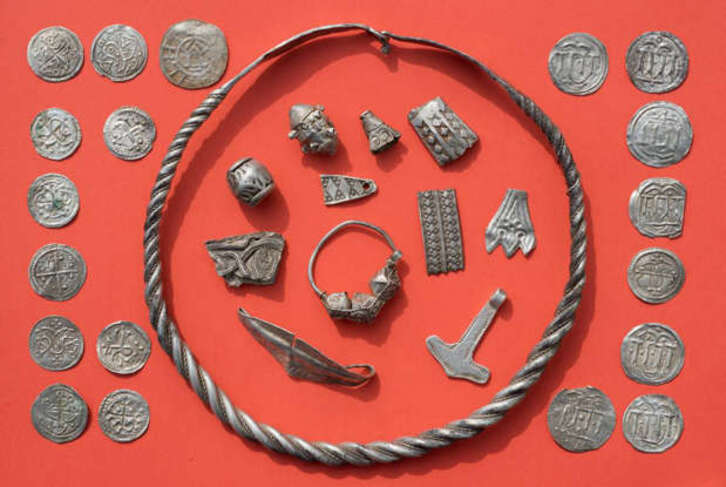
Source: Stefan Sauer/picture alliance via Getty Images
“It’s a thing of dreams to find something like this,’ said Andrew, 35, after his discovery. “If we had found one coin we would have been over the moon.” The two realized that unearthing a find this large must have major significance.
What Do We Do Now?
After digging out everything they could find, the father and son drove home to Leeds to ponder their next step. Well, what would you do if you had the feeling you’d stumbled upon a historical cache?
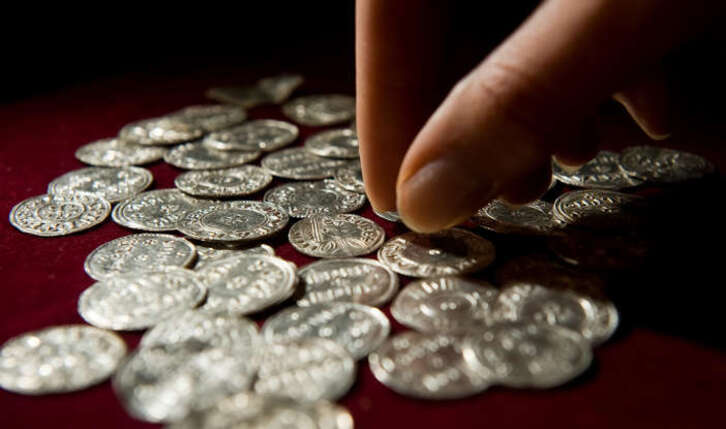
Source: LEON NEAL/AFP/Getty Images
The Whelans knew that they could not create a little Whelan Museum to show off their find, but had to report the finding to the Coroner’s Office. Something called the Treasure Act of 1996 made it law that one could not keep such treasures for themselves.
On to the Coroner’s Office! And the Britsh Museum! And the Coroner’s Office again!
The Whelans’ next step was to contact the local Coroner’s Office to report what they had found. They may have been hoping for a quick examination and determination of the age and value of the find. Those hopes were quickly dashed.
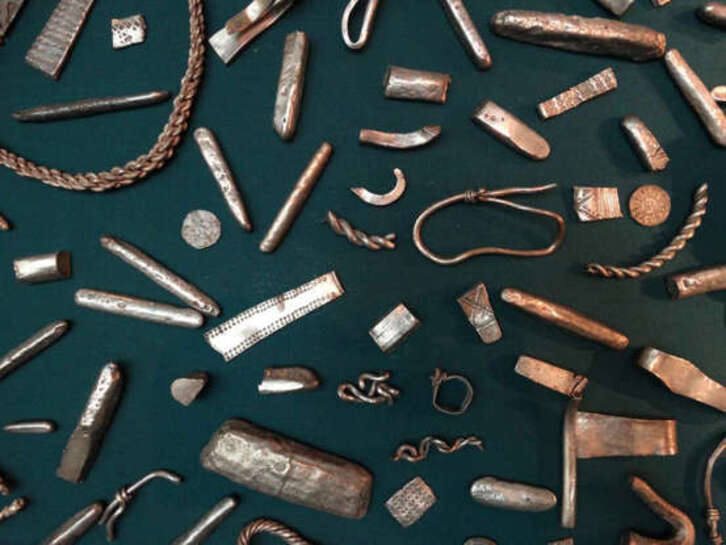
Source: Photo 12/ Universal Images Group via Getty Images
First Coroner sent the items to the British Museum.
Then the British Museum wrote a report about the artifacts.
Then the Coroner determined the value of the find.
Imagine the waiting – it took several months for the Whelans to hear back.
The Report Comes Back
It’s not every day that you hear you’ve discovered Viking treasure from the 10th century. The report concluded that the Whelans had found a true buried treasure belonging to a Viking king who brought it over to Anglo-Saxon England to bury it for safekeeping.

Source: Stefan Rousseau - PA Images/PA Images via Getty Images
Sometime around 927, the Viking king buried the items, hoping to come back later and dig them up. After all, the items were valuable solid silver and gold. So the king had stood right where David and Andrew stood, burying his treasure, over 1,000 years ago.
OK, OK, Fascinating, Now Tell Us the Value
While the Viking King owned the treasure, it had been manufactured outside of Viking lands and dated back to the 800s. All of the rings, armbands, necklaces, and cups added to the value of the find.
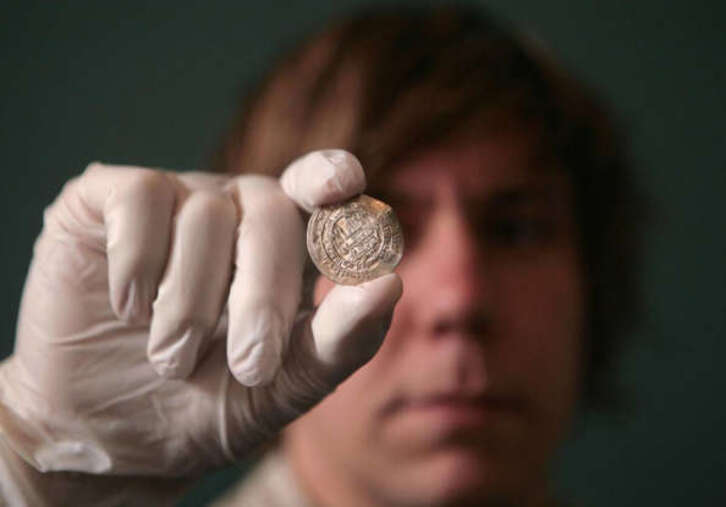
Source: Katie Collins/PA Images via Getty Images
Now the fact you’ve been waiting for (you’ve been very patient). The entire hoard came to $1,376,574. The cup alone is worth over $250,000. One would imagine the Whelans had to sit down after hearing this news.
So…How Much Did the Whelans Get?
Now here’s an unexpected twist in the story. One might imagine the British Museum staff happily carting away the treasures, thanking the Whelans profusely, and that would be the end of the story.

Source: Leon Neal/AFP/Getty Images
Instead, a judge determined that the Whelans must be paid by the British Museum for the collection. The cost was just over 1 million pounds, half going to the owners of the field, and a half to the Whelans. It took two years of fundraising by the British and York Museums to come up with that amount.
Whose Treasure Was it Anyway?
The treasure belonged to the Anglo-Saxon King Athelstan, who conquered Northumbria. Northumbria encompasses modern-day northern England and southeast Scotland. Most likely he amassed the silver and gold through purchase, trade, or looting.
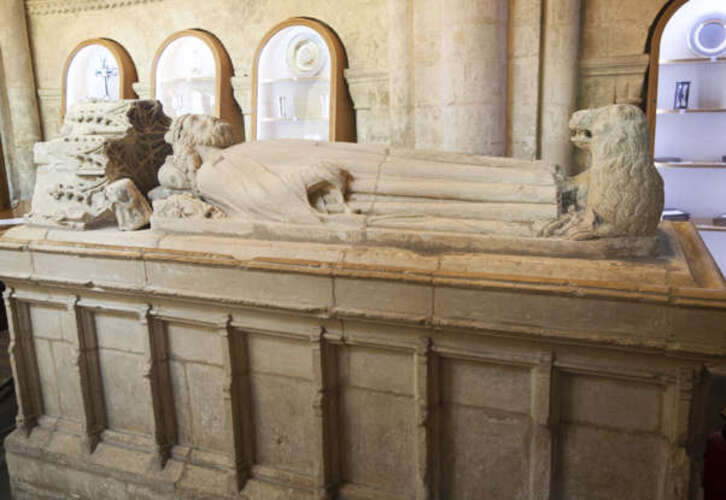
Source: Geography Photos/UIG via Getty Images
The year 927, when the King buried his treasure, was the year that Nortumbira became an area of unrest. One can imagine King Athelstan hurrying to bury his silver and gold in the field, planning to come back and find them. Instead, the Whelans found them 1,000 years later.
A Father and Son Make the Biggest Discovery in over 150 Years
The last discovery on this scale was in 1840 when the Cuerdale hoard of over 8,600 items from the 9th century, valued at over $3 million, was discovered in Lancashire.
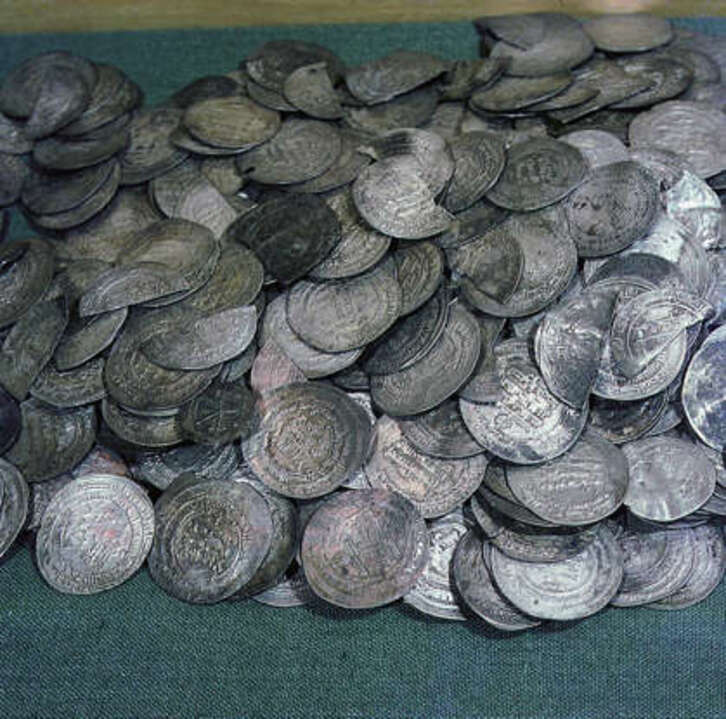
Source: Werner Forman/Universal Images Group/Getty Images
Barry Ager of the British Museum credits the find with providing new insight into the world of the Vikings. It proves, he says, that the Vikings had wide commercial dealings since the artifacts were produced in many different countries.
Look at the Coin Designs - and Start Re-Writing the History Books
When the Whelans dug up the coins, the mud and dirt obscured the designs. Then the British Museum experts carefully cleaned each coin and realized that each had a unique, and very detailed, design.
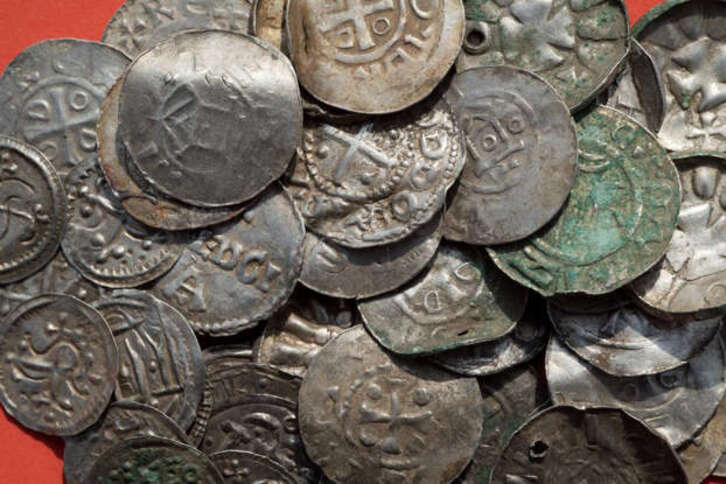
Source: Stefan Sauer/picture alliance via Getty Images
One coin has the inscription Rex Totius Britanniae, meaning “King of All Britain.” Thus, in 927 AD we have the earliest sign of Britain honoring one ruler. Time to re-write the history books.
More Re-Writes - The Vikings Traveled Widely
King Athelstan gathered these artifacts from many other countries, including France, Afghanistan, Baghdad, and Samarkand. There is even a ring from Russia and an armband from Ireland.

Source: Stefan Sauer/picture alliance via Getty Images
Viking history is now changed forever; historians realize now that they had a much farther range of international connections than ever known. Viking artifacts found in Yorkshire are nothing new. It’s where they came from that has shocked the scholars.
Let’s Learn Some Viking History
Now that this story brings up Viking history, let’s find out a little more. Since the eighth century, Viking communities seized areas of Scotland, Ireland, Wales, and England. There were so many invasions that Christian monasteries fought to maintain their religion while the Vikings introduced Pagan traditions.

Source: Culture Club/Getty Images
In the year 865 Danish Vikings invaded England and eventually ruled the area. In the 9th century Vikings from Norway conquered Scotland and the Isle and Man and Wales. These two invasions began the Anglo-Saxon rule of England
Viking Heritage in Yorkshire
Vikings ruled Yorkshire from 850 until 1016. York contains several sites famous for their Viking history. The Yorkshire Coroner Geoff Fell stated, “We are extremely proud of our Viking heritage in this area.”
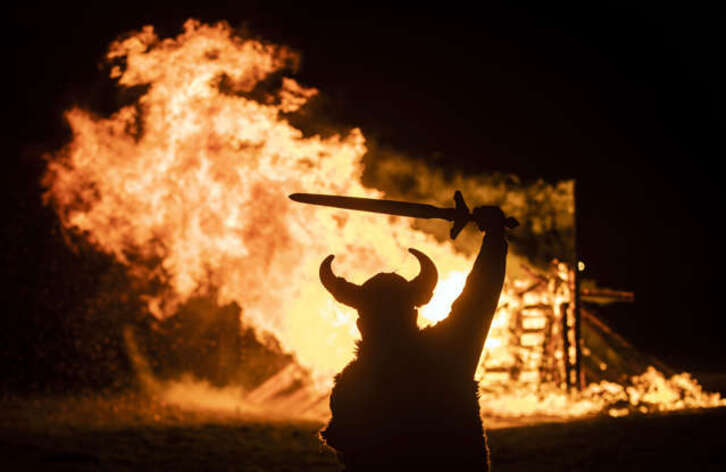
Source: Danny Lawson/PA Images via Getty Images
Geoff Fell must have been delighted when DNA testing was done in 2012, proving that York citizens’ lineage is remarkably more Norse than anywhere else in Britain.
What Else is In That Field?
One might imagine a kind of 19th-century Gold Rush of treasure hunters racing to the field where the Whelans found the items, digging madly to find more gold and silver. The Whelans, however, never disclosed exactly where they found the hoard. They have indeed returned to the spot and found nothing else.
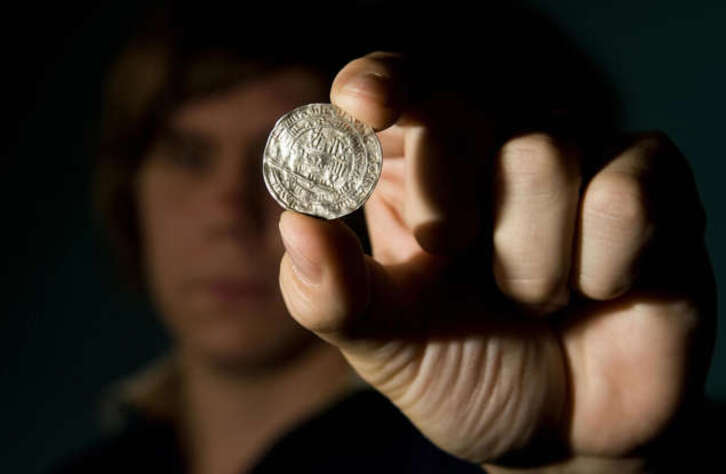
Source: Leon Neal/AFP/Getty Images
Since Yorkshire has deep roots in Viking history, it seems only a matter of time before such a treasure would be discovered in one of its fields. And yes, the hoard has legally been declared a treasure.
Would You Have Kept it for Yourself?
That’s a good question – but not one the Whelans ever asked themselves. They immediately turned it in so that others could enjoy it and be amazed at how well-preserved the items are.
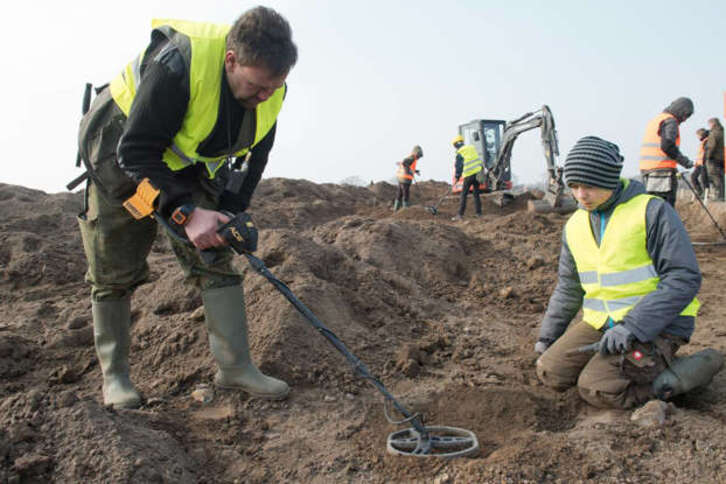
Source: Stefan Sauer/dpa
As the Culture Minister of the British Museum said, “I commend David and Andrew Whelan for their prompt and responsible reporting of this hugely significant find, which will enrich our understanding of the Vikings.”
The Harrogate Hoard - You Can Visit It
The treasure, originally called The Harrogate Hoard, went on display in the Yorkshire Museum in 2007, and then traveled to the British Museum. There it was renamed The Vale of York Hoard. “Harrogate Hoard” has kind of a ring to it, though.
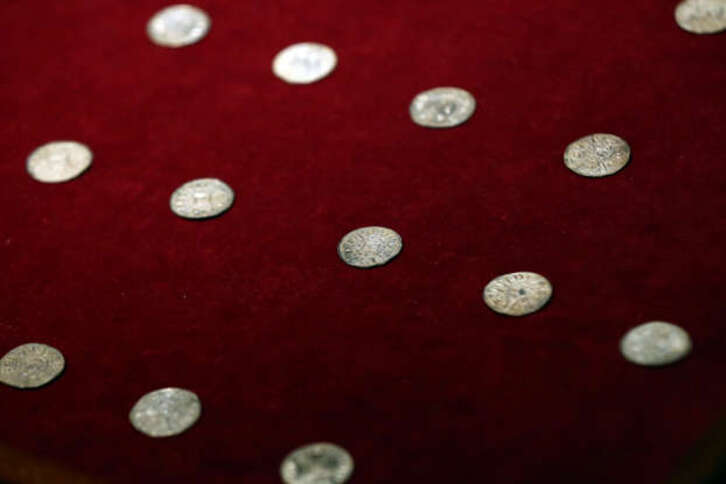
Source: Carl Court/Getty Images
Thousands of people got to see the treasure David and Andrew Whelan found in person while it was on display.
